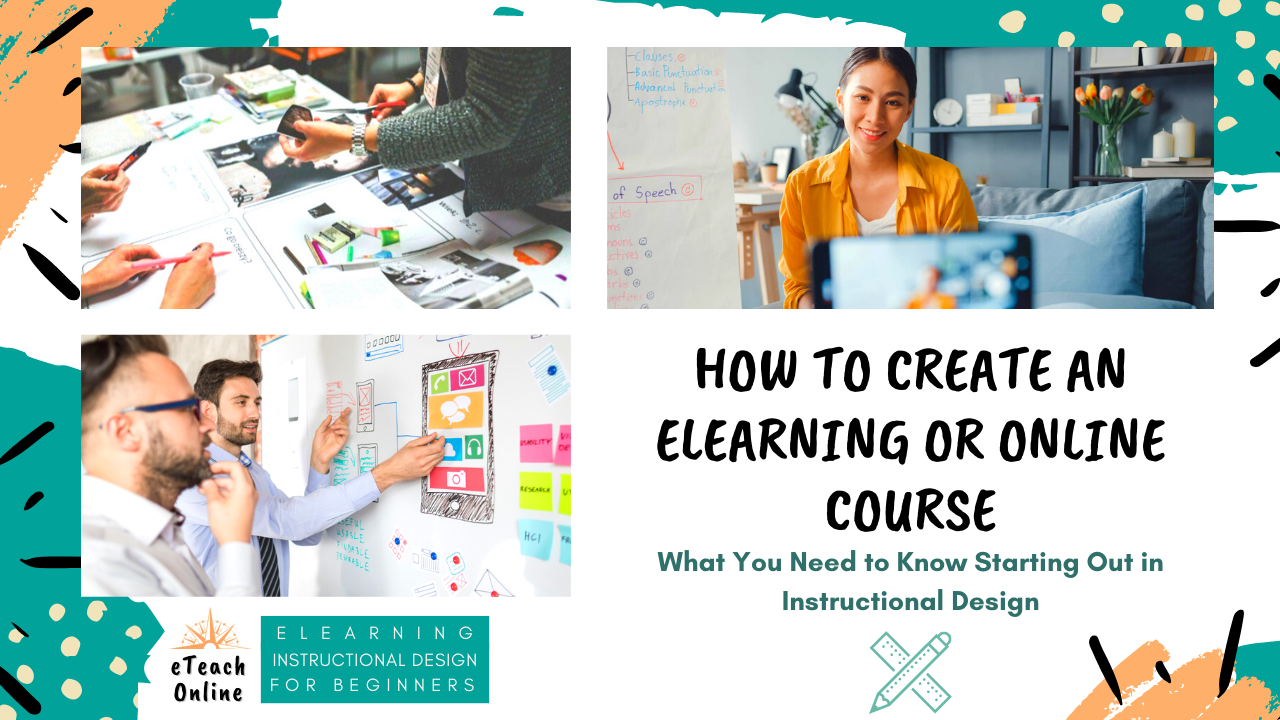How to Create an eLearning or Online Course - What You Need to Know Starting Out in Instructional Design

Are you new to instructional design or creating online courses and don't know where to begin?
Creating an eLearning course from scratch can seem like a daunting and overwhelming task if you have not learned the proper skills. Starting out, you may have questions like:
-
How do I come up with the appropriate content?
-
How do I organize the materials?
-
Where do I start?
-
What is the process?
-
How do I know when the course is ready?
All these questions will be answered after giving you a glimpse on how to follow research-based instructional design processes, even if you have no prior experience.
Steps in Getting Started With Creating an Online Course
1. Guide Your Learners
The first thing that you need to do is to think about the pedagogical differences between a face-to-face course and an online course.
Ask yourself:
-
How are you going to structure groups and discussions?
-
What kinds of things are you going to do to expect your learners to engage in real-world authentic tasks?
2. Selecting a Learning Management System
When selecting a learning management system (LMS) for the first time, choosing the right platform can be very critical for the success of your course.
Depending on the needs of your learners, you will want to ensure that the LMS has all the necessary features required for your learners to succeed.
Some of the features you will want to look for include:
- Usability
- Tracking
- Integration
- Customizability
If you would like to learn more about determining which LMS is appropriate for your learners, check out the blog post - 3 Steps to Selecting a Learning Management System
3. Select and Evaluate the Content
If you have a face-to-face course and are transferring it online, it is not about shoveling content into the learning management system. It is about thinking thoughtfully on how to integrate it in.
It’s also about finding resources that other people have already designed.
If you are transitioning to face-to-face materials to online, you may be wondering whether you can utilize the materials you already have created for your traditional face-to-face course.
It is important to evaluate the content to determine whether it will be interactive and engaging for your students online.
Ask Yourself:
- What instructional method would work best for this group of learners?
- What type of media (text, still images, audio, video, etc.) would best compliment the instructional methods?
- What materials should learners have supplied to them to assist with subject mastery?
If you would like to learn more about selecting and evaluating your course content, check out the blog post - Selecting and Evaluating Content - How to Select Tools, Media, and Materials for an eLearning Course
4. Create a Visual Plan AKA Storyboard
After determining the appropriate content, you need to create a visual plan, or storyboard, of everything that needs to be accomplished in the course.
Storyboards plot out eLearning course content, structure, and the overall flow.
Building a storyboard is great practice when determining what media to utilize in your course as it gives you the opportunity to think about how and where elements will fit into the course.
It will also help you with determining whether you have considered all necessary content to include in your course.
To learn in more detail exactly how to storyboard an online course, check out the blog post - Storyboarding for eLearning: How to Create, Develop, and Structure Interactive Online Courses
5. Place the Content into the LMS
After you have completed a visual plan, or storyboard, of your online course, it is now time to layout the materials onto the LMS you have chosen.
An important tip is to separate each module into weekly chunks, so that learners do not get overwhelmed with the materials.
Also depending on the age-level of your learners, be sure to include an appropriate amount of images throughout the course.
Enhance Your Knowledge

There is a lot that goes into creating a successful online course. The suggestions provided in this post will help get you on your feet, but it is important that you continue building your skills. However, it’s also important to not get too overwhelmed in the beginning. Start with the essentials and begin building from there.
Challenges You May Face
Creating an online course takes time and practice. Your course will not be effective if you simply just throw content together without strategizing. Another challenge you may face is being “technology phobic”. If you are having some trepidations about the technology, consider getting some training.
Advice and Guidelines
You need to understand the strengths and weaknesses of online learning.
Use consistency and innovation whenever possible.
The most important thing starting out is that the course is functional. Later on you can then build on it.
Know the learners. Know the learning objectives. Know yourself.
Once you have a clear understanding of the learners, selected a learning management system, determined the appropriate content, created a visual plan, and then laid out the materials onto the platform, you will have a much better chance of succeeding.
This process will help you on your way in becoming a master in eLearning and instructional design!
Are you ready? You probably need some additional support and help to get that course up and running in case there are problems. Join the eLearning and Instructional Design for Beginners Community.
Start your career in Instructional Design (ID) and eLearning. Build an online course from scratch and finish with mastery. Become a master in eLearning and instructional design without the burden of having to return to school.
Whatever you need help with, the community is there to help you master your skills. Interested in joining the community? Click here to get started
JOIN THE
eLearning and Instructional Design for Beginners Community
- In-depth courses & training
Access my rapidly growing library, attend monthly live training & accountability support groups
- Exclusive tools & members-only discounts
Tools, templates, downloads, checklists and more - plus receive special perks & discounts
- Supportive community & network
Feedback and support from fellow instructional designers, career-driven business owners, and experts who will keep you on track
Get Your Software Toolkit for Instructional Designers
Tools & processes that will help you plan, build, and grow your instructional design career and freelance business.



